
Day 7: Deciphering the culture code
Saryan Park & Painter’s Vernissage, Parajanov & Tumanyan Home-Museums
Yerevan
Unlike yesterday, sunshine was warming the ancient city of Erebuni (Yerevan as of today). As the city was a heritage of Urartian lands, the name of the city Yerevan originates from ‘Erebuni’. According to Urartian studies, sound “b” in Urartian language sounds like “v” in Armenian. Therefore, Erebuni has been converted into Yerevan.
After a short etymology lecture, we shall get back to that day’s plan. I had allocated my whole day to Yerevan and to its cultural values. To come to myself and to store some energy, I decided to have my breakfast at an outdoor café near the Martiros Saryan Park. I picked the corner table and enjoyed the empty streets of Sunday. After having a peek at the menu, I ordered some scrambled eggs, a French croissant and a big glass of fresh orange juice.
Naturally, as the café was serving only for me, my orders had arrived in a hustle.
Whilst thinking where to go, I cocked my head out of the window and saw an outdoor gallery where plenty of paintings were being displayed. The gallery, which was called as the “Painter’s Vernissage” was right in the center of the park, named after Martiros Saryan. As soon as I entered the outdoor gallery, paintings by modern artists were on sale at an exhibition zone. I got dizzy of the glorious examples of art. All of them, one by one, were so impressive, stylish and colorful that could draw your attention vehemently.
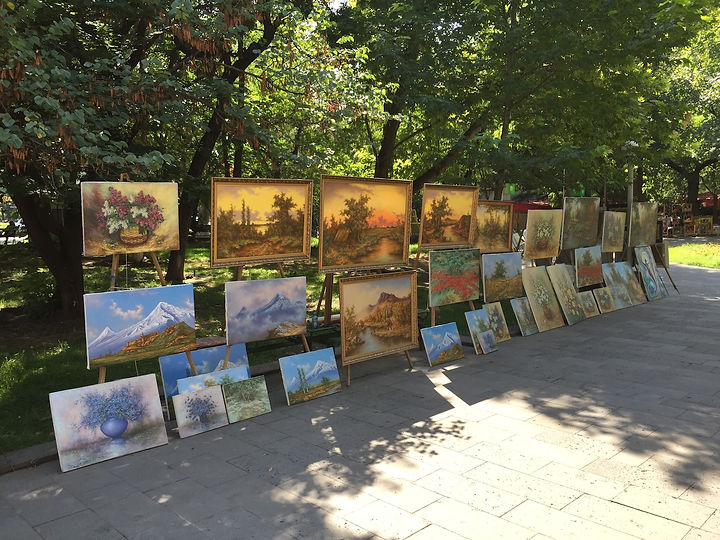
Painter’s Vernissage

Painter’s Vernissage
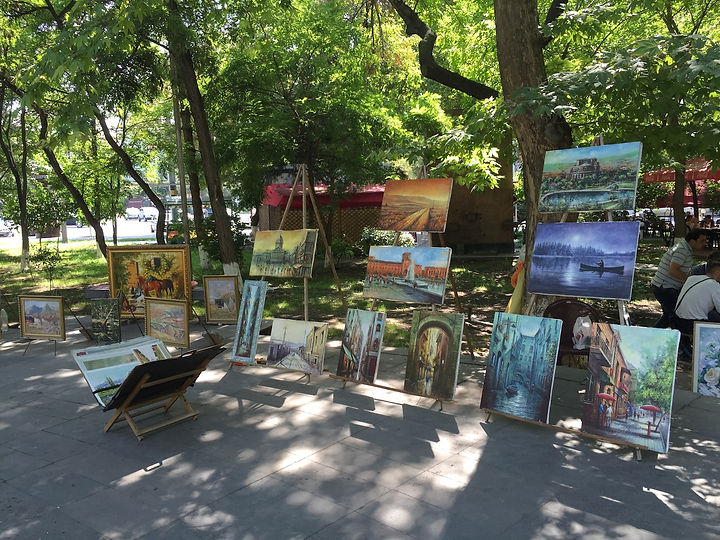
Painter’s Vernissage
The unique famous artist, Martiros Saryan, was honored with his statue at the heart of the park

Martiros Saryan
Martiros Sergeevich Saryan is recognized as the greatest artist of Armenia as he found the modern school of Armenian national art. He is known as the prominent master of color.
The color master was born in Russia, but spent more than half of his life in Soviet Armenia and passed away in his beloved city Yerevan. His long life spans the late 19th century until 1972. New humanistic “Saryan” art created by himself, contains lots of innovative ideas. He broadly reflects the characteristic features of ancient Armenian culture in his compositions of artistic work. The artist mostly worked on landscape and portrait paintings.
Currently, his entire path of creative evolution is being displayed at Martiros Saryan Home-Museum in Yerevan.
Additionally, quite a few paintings of his are still being exhibited in National Galley of Armenia, worldwide known Russian museums, best museums of USA, France and in some CIS (Commonwealth of Independent States) countries.
Saryan’s main works can be viewed via this link
Also, here is a virtual tour of Saryan’s Home-Museum
In Saryan Park, another statue of four men, arguing in an active walking pose, drew my attention.
The statue called “THE MEN” represents four famous actors Mher (Frunzik) Mkrtchyan, Avetik Gevorgyan, Armen Ayvazyan and Azat Sherents who played the main roles in the Armenian popular comedy “The Men (1972)”. The monument was dedicated to the 35th anniversary of the film and the 70th anniversary of the film director E. Keosayan.

THE MEN
As for that day, I devoted myself to discover the invaluable figures of Soviet Armenia. I’m then was heading to another brilliant artist’s home-museum. Our late hero was the greatest art director of Soviet-Armenia era.
Welcome to Sergei Parajanov’s Home-Museum!
The director, as seen in the picture hanging on his courtyard wall, was greeting his fans behind the scene.

At the entrance gate, the museum’s curator welcomed me. I got my ticket and dived into Parajanov’s brilliant past life full of creative artworks. On the first floor, generally, his works from his early ages were being displayed. Family portraits out of his talented fingers, colorful baby rag dolls, hand-made photo collages, extraordinary accessory designs reflect his gifted mind.
An interesting anecdote I acknowledged from the museum guide was that all the items were Parajanov’s handworks except the mannequin.

Sergei Parajanov Home-Museum
His passion in contemporary art, lead him to become an exceptional film director. In the 1960s, as his directing career peaked, he produced two masterpieces and gained a worldwide reputation in the film industry. His first masterpiece, created in 1964, was “Shadows of Forgotten Ancestors”. The film was counted as his first major work and earned him international acclaim for its rich use of costume and color. “Shadows of Forgotten Ancestors” features a rhapsodic comedy of Ukrainian folk culture. Unfortunately, after the film’s premiere, the Soviet authorities blacklisted him for his support of the Ukrainian dissidents and nationalists. The second masterpiece of him, “The colors of Pomegranates”, presented in 1969, has reinforced Parajanov’s fame as a film director. On the other hand, as the negative consequence of his second masterpiece, the film seriously jeopardized his career and himself. Right after the film had had launched, firstly the film was recut by the Soviet censors, and afterward he was sent to Ukrainian prison for 5 years due to his harsh criticism against Soviet cinema. The film itself, representing the biography of the greatest Armenian poet/ashik Sayat Nova, refused a license for export outside of the Soviet Union and was withdrawn after a two months circulation in the Soviet Union.

Sergei Parajanov Home-Museum
Proceeding my tour by going upstairs, a fashionable costume collage reflecting Parajanov’s artful character made my day. This kind of unique design could only come out from some magic hands.
Again on the second floor, in a spacious hall where dedicated to Sayat Nova, the trailer of his sensational film “The colors of Pomegranates” was displayed in a small screen.
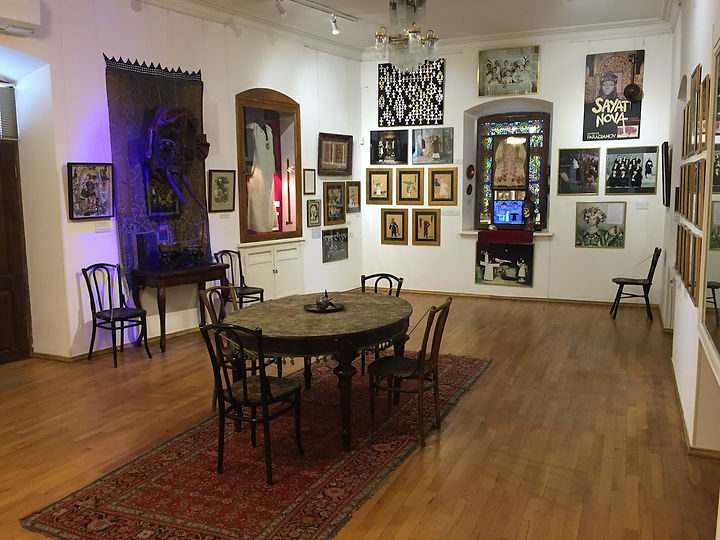
Sergei Parajanov Home-Museum
In the museum, one room was reserved as the artist’s living room from his teenager years where all his adolescence memories were spiritually regenerated.

Sergei Parajanov Home-Museum
I want to finalise our short journey to the great artist’s past life by sharing a quote declared for Parajanov:
“In the temple of cinema there are images, light and reality. Sergei Parajanov was the master of that temple.”
Jean-Luc Godard(French-Swiss film director, screenwriter and film critic)
Follow the link for Maestro’s films and biography
When I was done at the museum, I felt quite embarrassed not knowing this bohemian and eccentric character from Soviet-Armenia era.
My next stop was again a home-museum of another strong character from Soviet-Armenia. A figure of honor, an exceptional poet, a leader in Armenian literature, a political and public activist can be defined as his main titles.
This nobleman was called Hovhannes Tumanyan. Besides all his legendary titles, he was also considered to be the national poet of Armenia.

Tumanyan Museum
As soon as I entered the museum, a lady dressed in a formal but elegant suit greeted me at the entrance. She was the curator of the museum and asked me if I needed a guide. Although I rejected, she companied me telling interesting facts about Tumanyan to the next room. She said she couldn’t continue beyond that section, as she had to turn back to her place. Before she left, she introduced me a very famous painting of Martiros Saryan and informed me that the painter gifted this fabulous painting to Tumanyan.
The colorful painting, where Debet River flew underneath a valley, was one of Saryan’s masterpieces showing up Tumanyan’s birthplace, Lori.

Saryan’s masterpiece “LORI” Tumanyan Museum
There stood another lady, much older than the curator, and started giving a brief of every single window display. Surprisingly, this old lady seemed to like knowing Tumanyan from his birth. The information she provided and the stories she told were extensively detailed as it affirmed her deep knowledge about Tumanyan.
We stopped in front of every single window display and every time we stopped she had something to tell. Walking by the window displays of the exhibition, I noticed what a perfect writer Tumanyan was. His works, generally poetic ones, were enlightening the Armenian everyday life, culture and the society with respect to ordinary activities of simple people.
Tumanyan home-museum was very well organized and his life span was displayed in chronological order. Poems, fables, quatrains, ballads and novels of his individual work were spread all over the place behind those window displays. His poems usually ended up with sorrow, sadness and bitter.
Here I share one of his flamboyant poems, and my favorite, “Akhtamar”:
Beside the laughing lake of Van
A little hamlet lies;
Each night into the waves a man
Leaps under darkened skies
He cleaves the waves with mightly arm,
Needing no raft or boat,
And swims, disdaining risk and harm,
Towards the isle remote.
On the dark island burns so bright
A piercing, luring ray:
There's lit a beacon every night
To guide him on his way.
Upon the island is that fire
Lit by Tamar the fair;
Who waits, all burning with desire,
Beneath the shelter there.
The lover's heart-how doth it beat!
How beat the roaring waves!
But, bold and scorning to retreat,
The elements he braves.
And now Tamar the fair doth hear,
With trembling heart aflame,
The water splashing-oh, so near,
And fire consumes her frame.
All quiet is on the shore around,
And, black, there looms a shade:
The darkness utters not a sound,
The swimmer finds the maid.
The tide-waves ripple, lisp and splash
And murmur, soft and low;
They urge each other, mingle, clash,
As, ebbing out, they go.
Flutter and rustle the dark waves.
And with them every star
Whispers how sinfully behaves
The shameless maid Tamar;
Their whisper shakes her throbbing her
This time, as was before!
The youth into the waves doth dart,
The maiden prays on shore.
But certain villains, full of spite,
Against them did conspire,
And on a hellish, mirky night
Put out the guiding fire.
The luckless lover lost his way,
And only from afar
The wind is carrying in his sway
The moans of: 'Ah, Tamar!'
And through the night his voice is heard
Upon the craggy shores,
And, though it's muffled and blurred
By the waves' rapid roars,
The words fly forward-faint they are-
'Ah, Tamar!'
And in the morn the splashing tide
The hapless yough cast out,
Who, battling with the waters, died
In an unequal bout;
Cold lips are clenched, two words they bar: 'Ah, Tamar!'
And ever since, both near and far,
They call the island Akhtamar.
A
K
H
T
A
M
A
R

Whilst touring the museum with guidance, we came across to a 3D dynamic hologram, displayed in a dark room. The hologram represented Tumanyan sitting in a chair reading his newspaper and wandering in his room, perhaps thinking of some genius ideas.

Tumanyan Museum
As I continued exploring the poet’s life, on another window display, acknowledged about his routine meetings with his close intellectual friends from the literature society. That gatherings, which was called Vernatoun, was briefly explained in the picture…
Tumanyan Museum
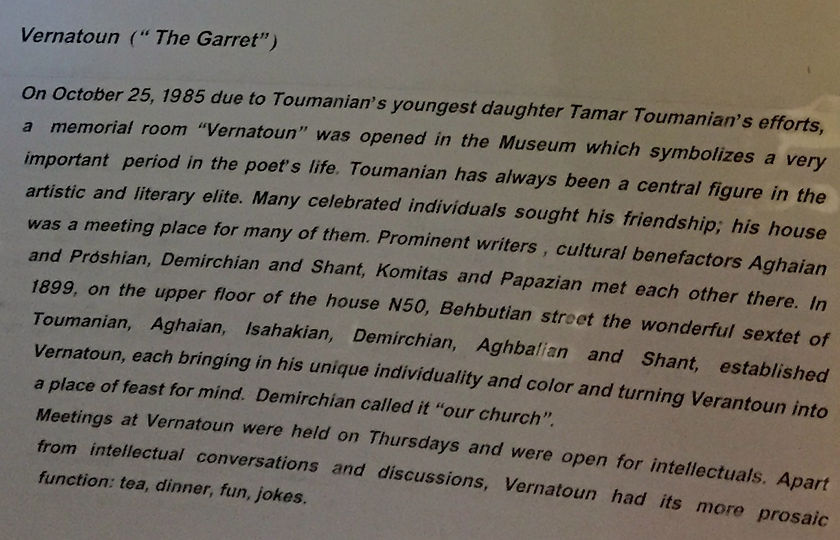
Tumanyan Museum
As an outcome of Tumanyan’s magnificence in literature, films, animated films and operas were adapted from his work. The most popular and worldwide known adaptation was the Opera called, “Anoush” based on his novel with the same name.
The five-act opera composed by Armen Tigranian was the first opera truly inspired by Armenian folk music and culture. It is still considered as the most popular musical and theatrical work in Armenian opera. The plot reveals the tragedy of a peasant girl (Anoush) whose short love affair ends in loss and death because of conflict between her lover (Saro) and her brother (Mossy). Post Saro’s death, Anoush becomes insane with grief, ends her life by throwing herself off a cliff. This heart-breaking ending hits the audience very deeply, so that the opera becomes legendary.
Here in the picture displayed the opera’s poster and publications with the heroes who took part in the play.

Anoush Opera, Tumanyan Museum
I, then, went upstairs to have a look at his rooms where he spent most of his time. As he had a big family with 10 children, all of his children’s past lives were also being represented in their own private rooms. Also, his living room, full of precious cutlery on the dining table and old-fashioned elegant furniture covering the family atmosphere, were displayed in a one to one prototype room.
The ancient scent of the room captured my deep interest and took me to a far away journey to those years in the past.
Having finished my visit, I headed to the exit. Before I left the building, I had a warm chat with the curator, thanking for her hospitality and wishing her good luck. Meanwhile, she wondered, of course, where I was coming from and how fluent I spoke the Russian language as a foreigner.
I told her a bit of myself, giving short background info. Then, she also told me where her roots belonged. She had an Assyrian descent, living for a long time in Yerevan.
It was almost 3 o’clock in the afternoon when I left Tumanian Museum. I was starving and I needed an urgent solution. Suddenly, I remembered of my close relative Ani, and her advice. She had been to Yerevan before and loved the lahmacun in that restaurant. Therefore, I sat on the driver’s seat, turned on my navigation, and followed the route as appeared on my phone.
I reached “Mer Taghe” and immediately ordered two lahmacuns and an ayran, of course, as a must drink which goes ideal with lahmacun. Fortunately, the service was quick enough that they brought my lahmacuns in a short time. Lahmacun, as known as Turkish pizza worldwide, is a round thin piece of dough topped with minced meat (most commonly beef or lamb) and minced vegetables with herbs including onions, tomatoes, parsley and red pepper flakes. The dish was also a very popular item in Armenian cuisine and was pronounced as Armenian pizza by various sources. Its crusty super balanced baked dough underneath minced tasty beef was satisfactory. As I devoured lahmacuns, I would love to order some more dishes from the menu, but I decided to come again for the dinner not to spoil the delicate taste left on top of my tongue.
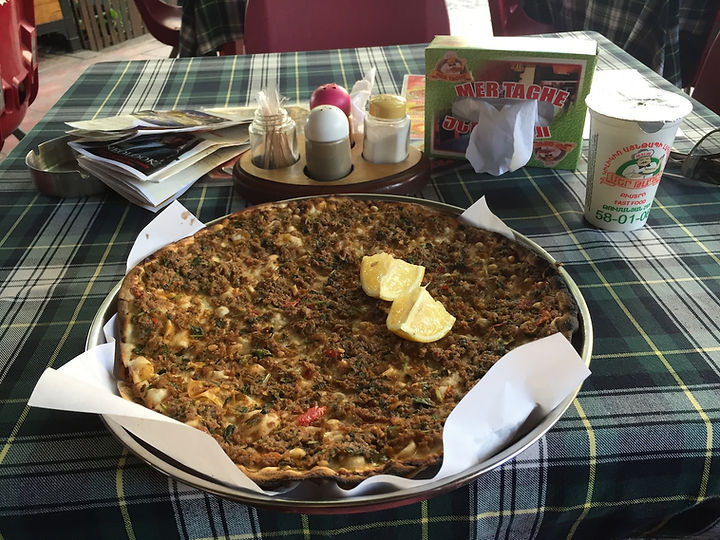
Mer Taghe
During the time I was waiting for my meal, I had glanced the city map and spotted where to go next. I had preferred to go a beautiful and peaceful park based around Vardavar Lake. I had sat on a bench and had read my book in silence.
Lyon Park was popularly known as Tokhmakh, due to renovation works by Turkic ruler of Yerevan Mehmet khan Tokhmakh. Despite the fact that the lake was artificial, the park had a natural look and pure beauty. The bench I had chosen to relax and read my book, had had a perfect lake view under the trees.

Lyon Park
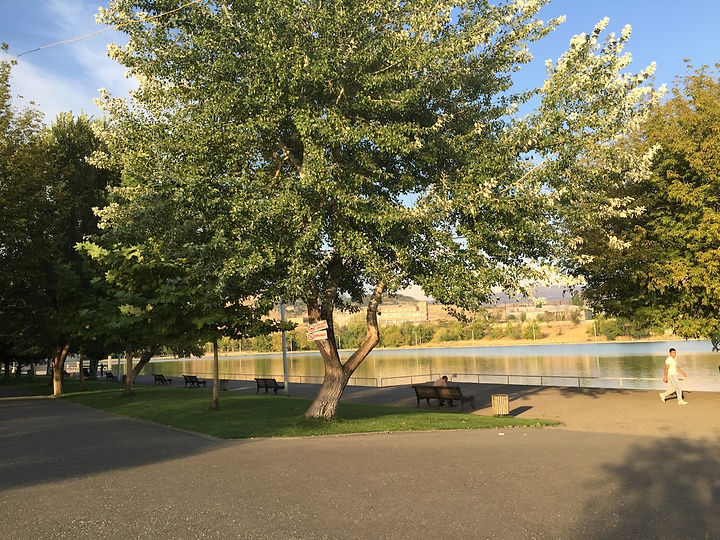
Lyon Park
It was time to leave the park, after spending an hour there. Before the sunset, I wanted to discover some more monuments in the center of the town, to get to know valuable symbols of Armenian culture. So, I parked my car near the Shahumyan Square to see Stepan Shahumyan’s big statue and acknowledge that heroic character. The wide square was dedicated after him, as a fallen hero of the Russian revolution.
Throughout the Soviet Union's existence, Khankendi in the Nagorno-Karabakh region of the Azerbaijan SSR was renamed as Stepanakert, after Shahumyan. Stepan Georgevich Shaumian was a Bolshevik revolutionary and politician, famed as Commissar Extraordinary for the Caucasus. His epic role as a leader of the Russian revolution in the Caucasian territory, earned him the nickname ‘Caucasian Lenin’. The statue to honor him was erected in 1931(first ever statue built in Yerevan) and since then it stands there at the square.

Shahumyan Square
The time flows so quickly when you move from one place to another in a hurry, with the desire of seeing everything possible on your way. So, I have seen the wall clock showing 7 o’clock in the evening, when I got back to my hostel. I accessed my room and met a new guy coming from the neighbor country, Iran. Having had a short conversation with him from this and that, headed to the bathroom to take a warm revitalizing shower.
Having felt much more relieved after the shower, I donned my clothes rapidly and went out for a walk. On my way, as I felt responsible for revealing all the cultural symbols of Yerevan that day, I halted at the backside of the Opera House to take a snapshot of the great statue of Aram Khachaturyan.
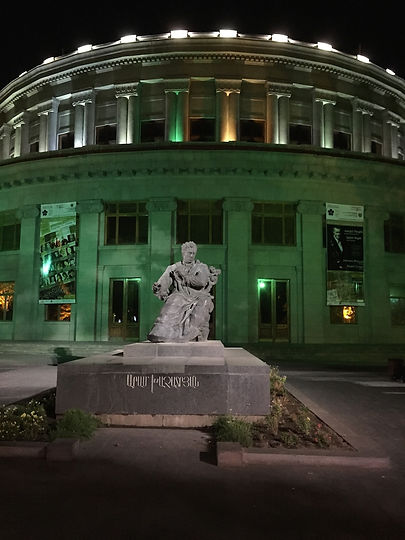
Aram Khachaturyan statue at the backside of The Opera House
Aram Il'yich Khachaturian, considered as the national treasure, is very highly regarded in Armenia due to his successful career in composing and conducting musicals, symphonies, concertos and ballets. He is globally famous of his ballets, Gayane and Spartacus. Other than ballets, his concertos named Piano Concerto in D-flat major (1936), Violin Concerto in D minor (1940) and Cello Concerto in E minor have earned respect all over the world and had been the inspiration for international artists. Moreover, he provided his musical compositions to films, plays, theaters and chamber ensembles.
At last, I’m closing this subject by sharing one of his quotes spoken to his disciples:
“First of all, I demand from my students an initiative. I would rather excuse one’s technical mistakes, than the absence of their own thoughts. No pedagogue can give what music, musical practice, life can give…
The more impressions of life an individual has, the more creative ideas are born, and the more interesting and substantial is their realization.”
Aram Khachaturian
Since I promised myself at lunch to revisit the same place for the dinner, after some walkabout in the city center, I again ended up in Mer Taghe. That time, I ordered Khachapuri with eggs, better known as Adjarian Khachapuri. This traditional dish was actually Georgian based but also became popular in the Post-Soviet era. So, it was also a common dish in Armenia.
By the way, Khachapuri is commonly prepared in a bit different way in Black Sea region of Turkey and is called pide. The idea and the taste are almost the same as well as the baking process. Anyway, there in Mer Taghe the taste was appetizing as it was neither crusty nor doughy, but very well balanced cooked.

Mer Taghe
For the second time in one day, I gobbled up my meal; though, I needed a short digesting walk. As I was on the Tumanyan street, I walked up the street, made a right to Mesrop Mashtots Avenue, climbed up again to France square and by there finally got to Alexander Tamanyan park. Armenian neoclassical architect, Alexander Tamanyan, was posthumously honored by a statue built for his commemoration. He was the author of some towns in Armenia, including Yerevan. His most famous work was drawing the main layout plan for rebuilding Yerevan. The city layouts of Etchmiadzin, Gyumri and Stepanakert were also his work.
Tamanyan also played a significant role in designing great buildings in Yerevan, such as the Government house, Opera and Ballet house, State Medical University and Engineering University.
Besides those big-scale projects, he worked on framing the squares of Yerevan like Freedom Square and Republic Square and the surrounding buildings. The talented architect was also involved in the development of restoration works of historical landmarks in the country. Architect was born in 1878 in Krasnodar and he died in 1936 in Yerevan. Tamanyan fitted his short life plenty of masterpieces and played a major role in country’s architectural development to become modernized.

Alexander Tamanyan
At the park, an open-air art gallery was being presented, but it was really too dark to view the items. So, I decided to add this exhibition to the next day’s agenda and walked back to the hostel to get some sleep.
